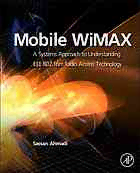Table Of ContentMobile WiMAX
To my wife Shahrnaz and my children Roya and Nima
Mobile WiMAX
A Systems Approach to
Understanding IEEE 802.16m Radio
Access Technology
Sassan Ahmadi
AMSTERDAM(cid:1)BOSTON(cid:1)HEIDELBERG(cid:1)LONDON(cid:1)NEWYORK(cid:1)OXFORD
PARIS(cid:1)SANDIEGO(cid:1)SANFRANCISCO(cid:1)SINGAPORE(cid:1)SYDNEY(cid:1)TOKYO
AcademicPressisanimprintofElsevier
AcademicPressisanimprintofElsevier
TheBoulevard,LangfordLane,Kidlington,Oxford,OX51GB,UK
30CorporateDrive,Suite400,Burlington,MA01803,USA
Firstpublished2011
Copyright(cid:1)2011ElsevierInc.Allrightsreserved.
Nopartofthispublicationmaybereproducedortransmittedinanyformorbyanymeans,electronicormechanical,
includingphotocopying,recording,oranyinformationstorageandretrievalsystem,withoutpermissioninwritingfromthe
publisher.Detailsonhowtoseekpermission,furtherinformationaboutthePublisher’spermissionspoliciesandour
arrangementwithorganizationssuchastheCopyrightClearanceCenterandtheCopyrightLicensingAgency,canbefoundat
ourwebsite:www.elsevier.com/permissions
ThisbookandtheindividualcontributionscontainedinitareprotectedundercopyrightbythePublisher(otherthanasmay
benotedherein).
Notices
Knowledgeandbestpracticeinthisfieldareconstantlychanging.Asnewresearchandexperiencebroadenourunder-
standing,changesinresearchmethods,professionalpractices,ormedicaltreatmentmaybecomenecessary.
Practitionersandresearchersmustalwaysrelyontheirownexperienceandknowledgeinevaluatingandusing
anyinformation,methods,compounds,orexperimentsdescribedherein.Inusingsuchinformationormethodstheyshouldbe
mindfuloftheirownsafetyandthesafetyofothers,includingpartiesforwhomtheyhaveaprofessionalresponsibility.
Tothefullestextentofthelaw,neitherthePublishernortheauthors,contributors,oreditors,assumeanyliabilityforany
injuryand/ordamagetopersonsorpropertyasamatterofproductsliability,negligenceorotherwise,orfromanyuseor
operationofanymethods,products,instructions,orideascontainedinthematerialherein.
BritishLibraryCataloguinginPublicationData
Ahmadi,Sassan.
MobileWiMAX:asystemsapproachtounderstandingtheIEEE
802.16mradioaccessnetwork.
1.IEEE802.16(Standard)2.Wirelesscommunication
systems.3.Mobilecommunicationsystems.
I.Title
621.3’84-dc22
LibraryofCongressControlNumber:2010935393
ISBN:978-0-12-374964-2
ForinformationonallAcademicPresspublications
visitourwebsiteatwww.elsevierdirect.com
PrintedandboundintheUnitedStates
1011121110987654321
Contents
Preface..................................................................................................................................................xi
Introduction..........................................................................................................................................xv
Acknowledgements..........................................................................................................................xxvii
Abbreviations....................................................................................................................................xxix
CHAPTER 1 Introduction to Mobile Broadband Wireless Access........................1
1.1 Mobile Broadband Wireless Access Technologies....................................................1
1.1.1 The4thGeneration of Mobile Broadband WirelessAccess
Technologies......................................................................................................4
1.1.2 Requirementsof 4GMobile Broadband Wireless Access Systems.................6
1.1.3 Convergence ofMobile Broadband Wireless Access
Technologies....................................................................................................13
1.2 Introduction tothe IEEE 802.16 Standards.............................................................14
1.2.1 Evolutionof the IEEE 802.16 Standards........................................................19
1.3 Introduction toWiMAX Forum Mobile System Profiles........................................23
1.4 Introduction to3GPP Standards...............................................................................24
CHAPTER 2 WiMAX Network Architecture......................................................33
2.1 Design Principles of WiMAX NetworkArchitecture..............................................33
2.2 Network Reference Model.......................................................................................37
2.2.1 Access Service Network (ASN)......................................................................38
2.2.2 Access Service Network Gateway (ASN-GW)..............................................39
2.2.3 Reference Points..............................................................................................40
2.2.4 Connectivity Service Network(CSN)............................................................42
2.3 Authentication, Authorization,and Accounting(AAA)..........................................42
2.4 Mobile IP..................................................................................................................44
2.5 Radio Resource Management (RRM)......................................................................46
2.6 Mobility Management..............................................................................................47
2.6.1 ASN-anchoredMobility..................................................................................47
2.6.2 CSN-anchoredMobility..................................................................................50
2.7 Pagingand Idle State Operation..............................................................................51
2.8 Overviewof 3GPPEvolvedPacket Core NetworkArchitecture............................52
CHAPTER 3 IEEE 802.16m Reference Model and Protocol Structure................61
3.1 The IEEE 802.16m Reference Model......................................................................63
3.1.1 TheMS and BSInterface...............................................................................66
3.1.2 NetworkControland Management System....................................................67
3.1.3 Data-Plane.......................................................................................................69
v
vi Contents
3.1.4 Control-Plane...................................................................................................71
3.1.5 Management-Plane..........................................................................................73
3.1.6 Service Access Point.......................................................................................74
3.1.7 Media-IndependentHandoverReference Model for IEEE 802.16................75
3.2 The IEEE 802.16m Protocol Structure....................................................................76
3.2.1 Data-Planeand Control-Plane Functions inBase Stations
andMobile Stations........................................................................................79
3.2.2 Data-Planeand Control-Plane Functions inRelay Stations...........................81
3.2.3 Protocol Structure for Support ofMulti-Carrier Operation...........................87
3.2.4 Protocol Structure for Support ofMulticast and Broadcast
Services............................................................................................................88
3.3 3GPP LTE/LTE-Advanced Protocol Structure.........................................................89
CHAPTER 4 IEEE 802.16m System Operation and State Diagrams....................97
4.1 IEEE 802.16m Mobile Station State Diagrams.......................................................98
4.1.1 InitializationState.........................................................................................101
4.1.2 Access State...................................................................................................104
4.1.3 Connected State.............................................................................................108
4.1.4 IdleState........................................................................................................111
4.2 NetworkEntry........................................................................................................118
4.2.1 Normal NetworkRe-Entry............................................................................121
4.2.2 Fast Network Re-Entry.................................................................................122
4.3 State Transitionsand Mobility...............................................................................122
4.4 State TransitionsinRelay Stations........................................................................124
4.4.1 InitializationState.........................................................................................126
4.4.2 Access State...................................................................................................130
4.4.3 Operational State...........................................................................................130
4.5 Operational States ofFemto Base Stations............................................................131
4.6 3GPP LTE User Equipment States and State Transitions.....................................138
4.6.1 Acquisition ofSystemInformation...............................................................143
4.6.2 Connected Mode Mobility............................................................................145
CHAPTER 5 The IEEE 802.16m Convergence Sub-Layer................................ 149
5.1 Header Compression...............................................................................................150
5.1.1 RobustHeader Compression.........................................................................153
5.2 Service FlowClassification and Identification......................................................155
5.2.1 Service Flow Attributes.................................................................................156
5.2.2 Service Flow Types.......................................................................................156
5.2.3 Service Flow Classification...........................................................................157
5.3 PacketConvergence Sub-layer...............................................................................158
5.3.1 Packet CSPayload Header Suppression.......................................................159
5.4 Generic PacketConvergence Sub-layer.................................................................161
5.5 The 3GPP LTE Packet Data Convergence Protocol..............................................162
Contents vii
CHAPTER 6 The IEEE 802.16m Medium Access Control Common Part
Sub-layer (Part I)..................................................................... 169
6.1 Addressing............................................................................................................171
6.2 MACPDU Headers..............................................................................................173
6.2.1 Legacy GenericMACHeader.....................................................................173
6.2.2 IEEE 802.16m MACHeaders.....................................................................174
6.3 MACSignalingHeaders.......................................................................................181
6.3.1 Legacy MACSignaling Headers................................................................181
6.3.2 IEEE 802.16m Signaling Headers..............................................................183
6.4 Mobility Management andHandover..................................................................184
6.4.1 HandoverMechanisms................................................................................184
6.4.2 HandoverProcess........................................................................................196
6.4.3 IEEE 802.16m HandoverScenarios...........................................................199
6.4.4 Handoverto andFrom LegacySystems.....................................................206
6.5 Quality ofService.................................................................................................209
6.5.1 Legacy QoS Classes....................................................................................209
6.6 IEEE 802.16m QoS Classes.................................................................................215
6.7 MACManagement/Control Messages.................................................................217
6.8 Connection andSession Management.................................................................243
6.9 Mobility andPower Management........................................................................246
6.9.1 SleepMode Operation................................................................................247
6.9.2 Idle Mode Operation...................................................................................249
6.10 SchedulingServices.............................................................................................252
6.10.1 Persistent Scheduling................................................................................255
6.0.2 Group Resource Scheduling.......................................................................256
6.11 Bandwidth Request and Allocation.....................................................................258
6.12 Multi-radio Coexistence.......................................................................................261
6.13 3GPP LTE RadioResourceControlFunctions...................................................264
6.13.1 Mobility Management andHandover.......................................................268
6.13.2 Scheduling and Rate ControlFunctions...................................................271
6.13.3 DiscontinuousReceptioninRRC_CONNECTED State.........................274
6.13.4 Quality of Service.....................................................................................275
Appendix A: Proportional Fair Scheduling Algorithm.................................................277
CHAPTER 7 The IEEE 802.16m Medium Access Control Common Part
Sub-layer (Part II).................................................................... 281
7.1 Automatic Repeat Request.....................................................................................283
7.1.1 ARQ Principles.............................................................................................283
7.1.2 IEEE 802.16m ARQ Mechanism..................................................................284
7.1.3 ARQ StateMachine......................................................................................286
7.2 Hybrid Automatic Repeat Request Functions.......................................................289
7.2.1 HARQPrinciples...........................................................................................289
viii Contents
7.2.2 IEEE 802.16m HARQMechanism...............................................................292
7.2.3 HARQ Timing and SignalingProtocols.......................................................293
7.3 MACPDU Formation............................................................................................299
7.4 3GPP LTE Radio Link Control andMediumAccess ControlSub-Layers..........304
7.4.1 3GPPLTE MACSub-Layer.........................................................................304
7.4.2 Logical and Transport Channels...................................................................305
7.4.3 3GPPLTE RLC Sub-Layer...........................................................................310
7.4.4 ARQ andHARQinLTE...............................................................................314
CHAPTER 8 The IEEE 802.16m Security Sub-Layer....................................... 321
8.1 Security Architecture..............................................................................................321
8.2 Authentication.........................................................................................................323
8.3 KeyManagement Protocol (PKMv3)....................................................................323
8.3.1 KeyDerivation..............................................................................................323
8.3.2 KeyExchange................................................................................................324
8.3.3 KeyUsage.....................................................................................................324
8.4 Security AssociationManagement.........................................................................325
8.5 Cryptographic Methods..........................................................................................326
8.6 Control-planeSignaling Protection........................................................................326
8.7 User Privacy............................................................................................................328
8.8 3GPP LTE Security Aspects..................................................................................328
CHAPTER 9 The IEEE 802.16m Physical Layer (Part I) ................................. 335
9.1 OverviewofIEEE 802.16m Physical Layer Processing.......................................336
9.2 Characteristics ofWireless Channels.....................................................................338
9.3 SC-FDMA and OFDMA Principles.......................................................................342
9.4 Downlink andUplink Multiple Access Schemes..................................................355
9.5 IEEE 802.16m DuplexModes...............................................................................358
9.6 Frame Structure......................................................................................................358
9.7 The Concept of TimeZonesand FrequencyRegions...........................................363
9.8 Subchannelization andPermutation.......................................................................364
9.8.1 DownlinkSubchannelizationand Permutation............................................366
9.8.2 Uplink Subchannelization andPermutation.................................................374
9.9 Pilot StructureandChannel Estimation.................................................................382
9.9.1 PilotStructure Design Criteria.....................................................................383
9.9.2 DownlinkPilotStructure..............................................................................386
9.9.3 Uplink PilotStructure...................................................................................393
9.10 MIMO Midamble...................................................................................................394
9.11 Pilot-basedChannel Estimation.............................................................................395
9.12 Channel Coding andModulation...........................................................................398
9.12.1 Principles ofTurbo Coding........................................................................399
9.12.2 Coding andModulation ofTraffic Channels.............................................404
9.12.3 Coding andModulation ofthe ControlChannels......................................412
Contents ix
9.12.4 HARQ-IR Physical Layer Procedures........................................................415
9.12.5 ConstellationRearrangement......................................................................416
9.12.6 Performance ofChannel Coding and HARQ-IR.......................................416
9.13 SynchronizationChannel.......................................................................................418
9.14 Superframe Headers (Broadcast Channel).............................................................426
9.15 3GPP LTE Physical Layer Protocols.....................................................................448
9.15.1 Multiple Access Schemes...........................................................................448
9.15.2 Frame Structure...........................................................................................449
9.15.3 Physical Resource Blocks...........................................................................453
9.15.4 Modulationand Coding..............................................................................455
9.15.5 Physical Channel Processing......................................................................458
9.15.6 Reference Signals........................................................................................463
9.15.7 Physical ControlChannels..........................................................................467
9.15.8 Downlink and Uplink HARQ.....................................................................477
9.15.9 Physical Random Access Channel.............................................................477
9.15.10 Cell Search................................................................................................479
9.15.11 PDSCH Transmission Modes...................................................................480
CHAPTER 10 The IEEE 802.16m Physical Layer (Part II)............................... 489
10.1 ControlChannels.................................................................................................489
10.2 DownlinkControlChannels................................................................................490
10.2.1 Physical Structureof Advanced MAPs....................................................493
10.2.2 Advanced MAP Information Elements....................................................507
10.3 UplinkControlChannels.....................................................................................528
10.3.1 Fast-Feedback Channels...........................................................................530
10.3.2 HARQFeedback Channel........................................................................534
10.3.3 Sounding Channel....................................................................................536
10.3.4 Ranging Channel......................................................................................538
10.3.5 Bandwidth Request Channel....................................................................542
10.3.6 Power Control...........................................................................................544
10.4 Multi-Antenna Transmission Schemes................................................................548
10.4.1 Capacity of MIMO Channels...................................................................550
10.4.2 Spatial Multiplexingand Diversity..........................................................557
10.4.3 MIMOReceivers......................................................................................560
10.4.4 Precoding and Beamforming....................................................................564
10.4.5 Single-User and Multi-User MIMO.........................................................569
10.4.6 CollaborativeMIMOand CollaborativeSpatial Multiplexing................575
10.5 IEEE 802.16m Downlink MIMO Schemes.........................................................578
10.6 The IEEE 802.16m Uplink MIMO Schemes......................................................597
10.7 Multi-BSMIMO..................................................................................................601
10.8 Interference Mitigation........................................................................................607
10.9 Multi-Antenna Techniques in3GPP LTE...........................................................610
10.10 Multi-Antenna Techniques in3GPP LTE-Advanced.........................................617

